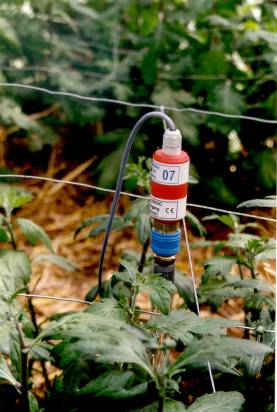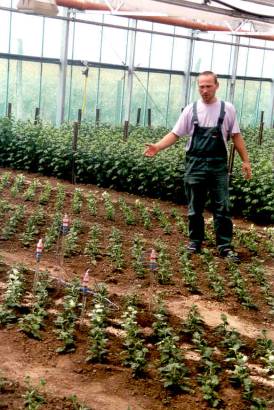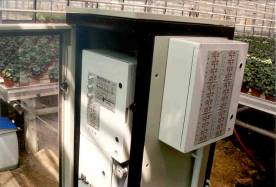 |
 |
 |
|
|---|---|
Innovative Tools
Irrigation Management on Soil
Contemporary greenhouse operations require precise control of irrigation and nutrient supply in order to optimize crop growth and minimize cost and pollution due to effluents. Moreover there is a need to minimize water and nutrient waste. In modern greenhouses nutrient supply is computer controlled and based on measuring salinity and compensating deficiencies by a mix of clean water and two stock nutrient solutions. The process of applying this solution to the crop presents several control problems such as time delays and seasonal variations due to plant growth. Progress has been achieved in model prediction of crop irrigation needs. Usually a transpiration model (Stanghellini 1987) is used that predicts plant transpiration based on ambient conditions (temperature, solar radiation and vapour saturation deficit). This approach leads to open loop control of water and nutrient supply based on model estimation of plant needs (Hamer 1997).
An intermediate approach has been proposed, where a crop transpiration model of convenient form is used to predict the necessary supply of water. In this intermediate approach, which has been applied to hydroponics cultures, the drain water flow from the crop is measured using an appropriate device. Using the error between drain measurement and model estimate the coefficients of the model are iteratively adapted. The adaptation process is continuous so that the model accounts for seasonal variation of crop growth. These results can be extended in cases of soil culture. Here there is no way to measure the water drainage directly hens one can use tensiometers in several depths, to measure the soil humidity and estimate the water drainage. In the Hoffmans greenhouse the methods developed for hydroponics cultures were extended to soil cultures in order to improve the quality of the crop and to conserve water and nutrients.
At Hoffman’s commercial greenhouse, in Germany, Macqu system is responsible for the irrigation of the crop. A part of the crop is in soil. Hoffman brothers wished to implement a new technique for the irrigation of that part of the crop, based on the measurements of three tensiometers installed in different depths.
The Method:
The irrigation water is supplied in specified time cycles. In particular for this application the irrigation was performed once per day at 11:00. In each cycle the amount of water supplied, (designated Vo), is automatically adjusted by the irrigation algorithm implemented by Macqu, in order to satisfy crop requirements and a desired predetermined water drainage. The approach taken is to ensure that only a control amount of drain water is spread to the subsoil (>30cm). This way we can ensure that there will be no salt accumulation near the roots of the plants and at the same time there will be no over irrigation.
In hydroponic cultures the desired drain is typically around 20% of the irrigation amount (Vo), required to secure desired nutrients concentration in the root environment. In the case of soil cultures, as it was previously mentioned, there is no direct way to measure the water drainage. For this reason a series of experiments were contacted in order to find the best way to control the drainage. The experiments involved soil humidity measurements in various depths in cultivated and non cultivated soil.
The results showed that the best way to estimate the drainage is to measure the peek (maximum over an irrigation period) soil humidity at a specific depth. In particular in our case we concluded that the best depth is 60cm.
To apply the method for the control of the water drainage, here, instead of aiming at a desired drainage (e.g 20% of Vo), we aim at a desired soil humidity at the depth of 60cm. The error between the desired soil humidity and the measured one is used to adjust the irrigation dose and the model parameters.
 |
 |
 |
|
|---|---|
The tensiometers and Macqu hydroponics machine at Hoffmans greenhouse